A primer on the state of Web3.

I strongly believe that the next wave of computing innovation along with entirely new sectors of the economy will be built on decentralized technology. This technology has rapidly evolved beyond its financial origins. The community encompasses constituencies ranging from musicians and artists to small business owners and government agencies. Smart regulation must reflect the diversity of potential users and use cases.
Decentralized technologies offer an alternative to a digital status quo that is increasingly dominated by big tech and oppressive regimes. Open, democratized systems can provide the infrastructure to power tomorrow’s economy and institutions. Realizing that potential will depend on collaboration between the government and the private sector to develop regulatory frameworks that encourage innovation while managing the risks inherent in different applications.
Before we start exploring the next iteration of the creator economy, through the lens of Web3 platforms, let’s take a step back and explore the history of the creator economy since the inception of the internet.
Web1 | The Information Economy → Content consumers (1985)
During the first era of the internet from the 1980s through the early 2000s internet services were built on open protocols (e.g., TCP, IP, SMTP, HTTP). This created a stable, level playing field on which to build the ecosystem of the internet. It was during this period of innovation that many of the biggest web properties were started.
Web1: “Read- Only”
Web1 refers to the first version of the web: read-only. Also called ‘The Information Economy’. Web1 examples are static web and personal sites, where the users’ role was mainly limited to reading the information provided by a few content producers, with no option for them to circle back to those creators. An example is AOL, which was consumption-only.
Web2 | Creators = Bloggers → Brand representatives (2004)
During the second era of the internet from the mid-2000s to the present businesses built a second layer of proprietary, closed protocols on top of the internet’s open protocols. This has been a period of centralization, as for-profit tech companies most notably *Google, Apple, Facebook, *and Amazon built software and services that rapidly outpaced the capabilities of open protocols.
As more people started gravitating to the internet, Web2 saw the rise of influential people who started blogging, gradually amassing significant fame and online audiences on platforms such as MySpace, Blogger, Soundcloud as well as Vinyl.
Web2: “Read → Write”
This is the world of Web 2.0. As the saying goes: “If you’re not paying for it, you’re not the customer. You’re the product.”
Thereafter, Web2 creators started monetizing their audience primarily via advertising, becoming the channels for other brands — allowing creators to earn revenue through affiliate advertising and sponsorship agreements. However, they were just the conduits of these other brands and businesses with no loyal attachment to the company.
Web3 | No more platform monopolies → Creator Ownership.
We are now in the early stages of developing Web3, in which communities are incentivized and rewarded for maintaining and developing core infrastructure.
In Web3, the definition of creator is changing as power dynamics shift from the platforms to the creators and their communities.
Today, the creator economy is no longer just about providing value to the platforms, it’s about new forms of direct creator-community relationships. There is an opportunity for creators *not only *to offer more to their fans (including financial upside) *but for both creators and their communities *to finally be able to participate in the collective value that they help platforms create.

Why does it matter?
The decentralized networks of web3 offer an alternative to the broken digital status quo.
While centralization has helped billions of people get access to amazing technologies, many of which were free to use, it has also stifled innovation.
Right now, companies that own networks have unilateral power over important questions like who gets network access, how revenue is divided, what features are supported, how user data is secured, and so on. That makes it harder for startups, creators, and other groups to grow their internet presence because they must worry about centralized platforms changing the rules and taking away their audiences or profits.
Web3: “Read → Write → Own”
The classic challenge of decentralized networks is that they are public goods. Without a central entity to control decisions and capture profits, it is hard to incentivize their maintenance and development. Crypto helps solve this problem through decentralized coordination and providing economic incentives for development. web3 will put power in the hands of communities rather than corporations.
Decentralized networks are an important counter to the fragility of centralized applications. Decentralized systems avoid single points of failure. Decentralized networks can also neutralize the unilateral control exerted by centralized platforms.
The Creator Economy refers to emerging communities of creators artists, musicians, and game developers who connect directly with their supporters and collaborate without intermediaries, enabling them to develop independent income streams.
“The Creator Economy is a subset of the passion economy the emerging category of businesses founded by self-employed content creators, supported by the digital platforms and financial tools that make the monetization of content viable.”
Platforms are becoming community-led where both creators and their audience members have the opportunity to have greater upside based on their contributions.
Why does it matter?
For many people, especially younger people who are spending more and more time online and in digital spaces, it is becoming increasingly popular to own digital versions of physical assets. Books, music, and movies like photographs exist as digital files saved on hard drives or in the cloud.
When you purchase a Non-Fungible Token (NFT), it’s yours to control as you see fit, similar to when you buy a physical good. You can transfer it, sell it, collateralize it, lend it, or keep it for yourself to admire. Early use cases for NFTs include digital art, games, sports memorabilia, and collectibles.
NFTs offer creators new ways to monetize, bypassing traditional gatekeepers and giving fans a direct stake in their success. They’re better for creators, who can sell their work directly without having to rely on middlemen (for example, artists who used to sell their artwork in galleries that took a cut or charged a fee). And they’re better for fans because they become owners, giving them an increased stake in the artists and creators they support.
Since NFTs are verifiable digital property rights, they also have many potential applications beyond the Creator Economy
The difference between creators and influencers
While influencers depend on brand deals, creators monetize their content directly through their audience via donations, tip jars, or paid community subscriptions.
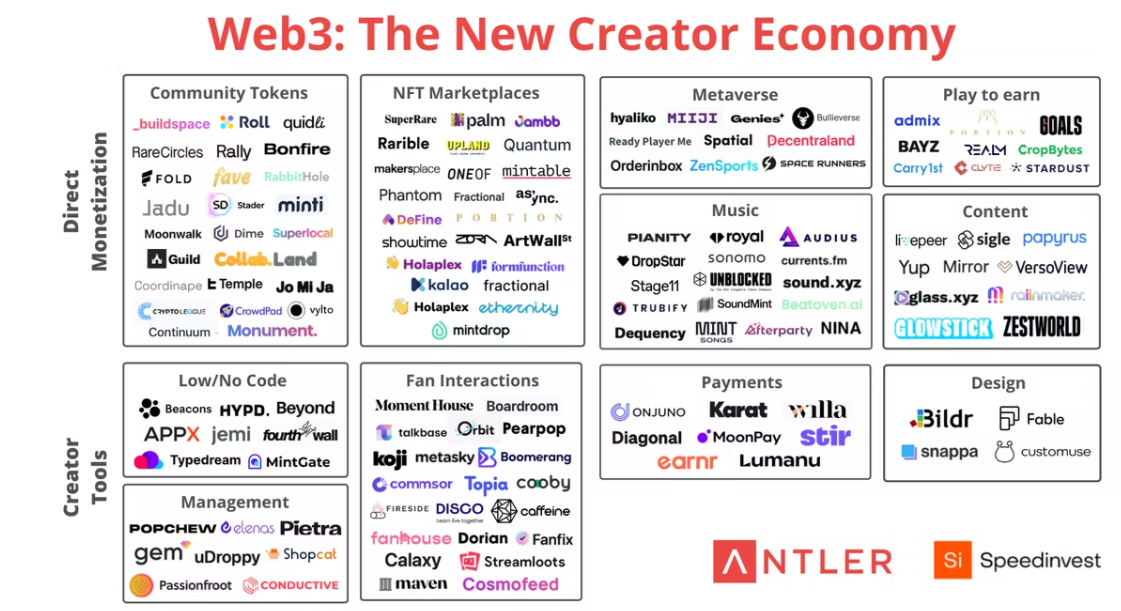
Influencers promote brands, products, services, affiliate links, or their merchandise. For them, content is a way to increase their followers and reach which in turn increases their price on the market.
Creators, on the other hand, focus only on the quality of content they produce. Through educational or entertaining content they hope to meet the interest and overcome the challenges of a specific audience.
The creator economy is estimated to be at $104.2 billion, with a noticeable growth rate when compared to that of the Gig Economy (trillion-dollar valuation in the future).
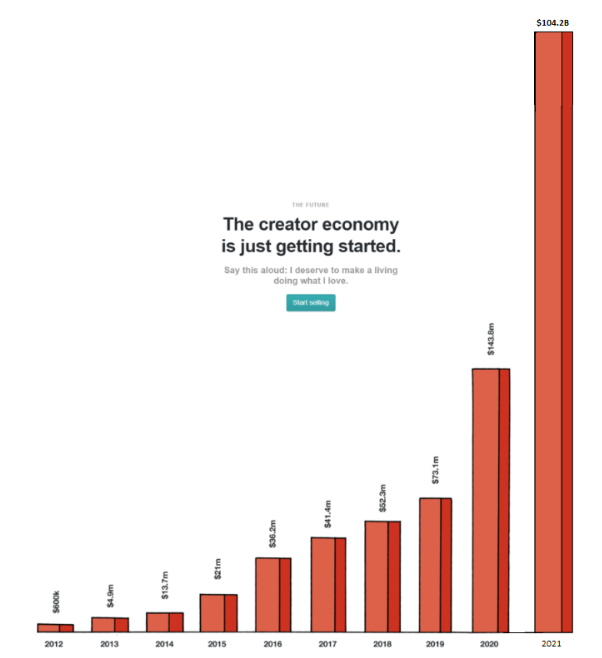
Creators combine multiple software tools to assemble a plethora of revenue streams in line with their style, no matter how niche. That’s a win for creators as well as everyone else. Because creators can finally build a real career while producing content tuned to every sub-culture in the rainbow.
Here is my twitter thread 🧵 summarizing what Web3 is all about.
Creator Market Size
If you consider that the Gig Economy is estimated to be valued at anywhere between $1–4.5 Trillion by 2023 and the Creator Economy is on a similar trajectory, then we’ve got some bold growth ahead of us — to $1 Trillion, and beyond! **Creators are businesses themselves. **The faster you realize that the quicker you can jump into this exploding market.
From social media platforms to other industries like Influencer Marketing to the more than 50 million Creators themselves to the 500+ new startups joining the scene, the Creator Economy is attracting multi-billion dollar attention.
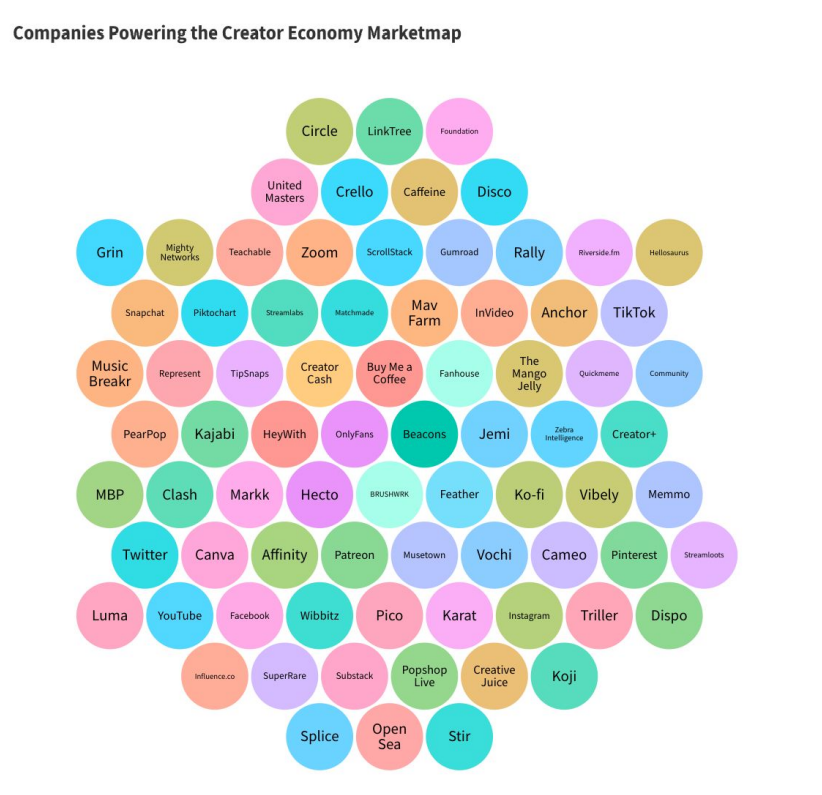
Creators’ Earning Power 💸
The side-by-side comparison of Creator size, income, and engagement shows the rising control Creators have over their accounts as full-time occupations and outlets for passion.
Earning power increases with time in the industry. 46% of Creators who have been building an audience for 4+ years earn over $20k annually across their monetized channels.

Measuring Success

Though income is most important for living costs, Creators on 4 out of 7 platforms listed Engagement Rate as their top measure of success, if they had to pick just one. Given the importance of reaching for personal branding and sponsorships, it’s no surprise that 17.11% of the Creators key in on engagement.

Content Creator Employees' Age Breakdown
Brands are hiring in-house content creators today and they are an integrated part of social media and marketing teams. But, these aren’t the typical content creators that you would think of for non-company-owned social media channels.
The age breakdown of content creator employees is much older with an **average age of 30-40 years old **definitely not Gen Z. Within the 30-40-year-old age bracket, this group accounts for 40% of the employee content creators. Should more brands be skewing younger?

Creators are the new founders 💫
Despite many creators facing challenges, there remains sufficient optimism for the creator economy to continue to expand. It gives new hope to people and opportunities for them to follow their passions. In this Covid-raved world, the creator economy offers unique opportunities for people to work from home and concentrate on the skills they have developed over time.
We’re at an inflection point in history where becoming a professionalized creator is one of the most desired jobs. Creators become creators because they love to create. As they grow their audience and expand their revenue channels, the burden of managing the day to day of their business grows heavier. Startups that will dominate the next stage of this evolution are ones that are centered around empowering creators to seamlessly monetize while staying focused on what they already love creating content.
Here is my twitter thread 🧵 summarizing What creator & Ownership economy is all.
Notable Insights 💫
- $800 million in venture capital has been invested into Creator Economy startups since October 2020.
- 46% of Creators who have been building an audience for 4+ years earn over $20k annually across their monetized channels.
- We estimate the total Creator Economy market size to be around $104.2 Billion and on par with a substantial growth trajectory similar to the Gig Economy. That’s a future valuation of TRILLIONS of dollars.
- 72% of Creators prefer Instagram and identify it as their primary content platform.
- Of the surveyed Creators.) that considered themselves full-time Creators, ie. content creation is their main source of income-78% make more than $23,500 annually.
- The power of sponsorships should not be underestimated. 77% of Creators depend on brand deals, that’s 3x as many as every other revenue source combined.
- There is not a definite correlation between follower count and income. Between the $50–100k and $500k-1M reported income levels from creating content, there are half a million dollars in income difference, but a difference of only 1.8K more followers.
Thirty years into the development of the world wide web, a handful of companies control most user attention and advertising revenue, with closed ecosystems that hold back innovation by independent developers. The economic interests of the biggest internet platforms are poorly aligned with their most valuable contributors: their users.
Ownership has long been embraced by Silicon Valley startups to align incentives among employees through option grants. Still, the vast majority of internet users own exactly 0% of the services they contribute to. Creators don’t own their content “NFTs make the internet ownable”, 2021, developers can’t control their code, and consumers can’t influence the policies or decisions of the platforms they use.
“The products and services that will define Web3 and the next generation of the internet are those that turn users into owners. We call this the ownership economy.” The ownership economy 2022 — Variant Fund
This scenario, which once went unquestioned, looks increasingly archaic. This is starting to change via the ownership economy often referred to as web3 with products and services that turn users into owners. What started with Bitcoin and Ethereum both of which reward participants who secure the network with their native tokens is becoming prevalent across all categories of software, from developer infrastructure and new financial markets in DeFi to consumer products, marketplaces, and social.
Amidst all this growth, we need to take a step back and re-introduce this ecosystem through some fundamental questions: what is the ownership economy? How big is it, and where is it headed? What trends are defining its current state and possible future?
What is it all about?
The ownership economy in its present form is an evolution of the sharing economy. This new economy ***builds on economic rewards from user participation, network effects, computing resources, community, and access to financial freedoms ***debased from traditional models.
The ownership economy gives people rights, sharing freedoms, monetization streams, and access through protocols to truly determine how they wish to participate, rather than a rigid form set by centralized systems. It means that the owner the user will determine how novel rewards, platform governance, or new forms of social capital will shape the future of user-generated value.
Simply put: the products and services that will define web3 and the next generation of the internet are those that transform users into owners. We call this the ownership economy
Why does it matter? - A new internet owned by users
If the last generation of software was built upon a foundation of user-generated content, the next generation of software will be user-owned, with digital ownership leveraged as a building block to enable novel user experiences. At its core, the ownership economy not only offers a powerful new tool for builders to leverage market incentives to jumpstart new networks it also holds the potential to create positive social change through the wider distribution of wealth-building assets.
Here is my twitter thread 🧵 summarizing what creator & ownership economy is all.
The ownership economy is big and growing 🚀
As of April 26th, 2022, the market capitalization of the over 19,000 tokens tracked by data aggregator CoinMarketCap is $1.76 trillion. For comparison, the market capitalization of global stock markets is over $100 trillion.
The largest crypto networks by market capitalization are established layer 1 blockchains: Bitcoin ($725 billion), which was launched in 2009, and Ethereum ($337 billion), which was launched in 2015. Other layer 1s in the top 20 tokens by market capitalization include Solana, Polkadot, Terra, and Avalanche.
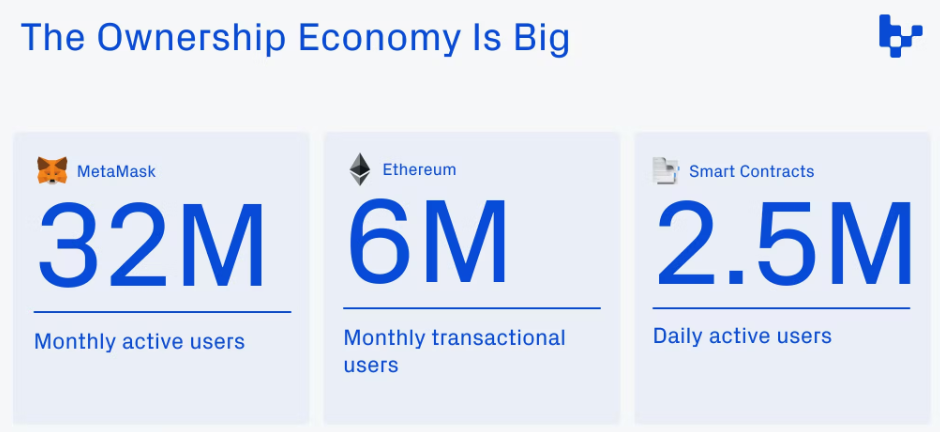
Source: Variant Fund
We can also think about the scale of the ownership economy in terms of people the users who become owners of the networks they build.
Paradigm Shifts in the Ownership Economy
Today, user ownership is transforming how people transact, invest, create, build, play, learn, communicate, and socialize.
✨Paradigm 1: Accessibility in the digital era shifting learned behavior
One of the key advantages of blockchain technology is the removal of intermediaries and supporting financial freedoms for individuals. While many advances have been made toward that end, without the ease of access, mass adoption cannot occur. Accessibility has remained the greatest barrier to cryptocurrency adoption and the advancement of a truly decentralized marketplace.
There has yet to be a natural on-ramp that clears the accessibility hurdle, while gradually evolving learned behavior to adopt cryptocurrency. Making the Digital Economy accessible and eliminating current barriers to entry that impede mass-market adoption
✨Paradigm 2: The key to Ownership
The advent of the digital era has brought with it an unprecedented generation of new value. New assets and commodities have generated incredible wealth for those able to create, extract, store and trade them.
As it stands though, the largest players in Big Data are intermediaries, adding friction to ecosystems while often treating individuals solely as resources to be exploited. Custodianship of user data has remained with the companies that collect it. For the most part, individuals are being ignored when the value their data generates is distributed they have been mostly removed from the upside of this digital commodity. The key to individual participation in the Digital Economy will be ownership and control of their own data.
✨Paradigm 3: Decentralization and WEB3
As the world works through this age of digital transformation, a massive shift in trajectory is also upon us. Since the start of the global pandemic, society has undergone a rapid acceleration in the adoption of all things digital. For the vast majority of the population though, the ability to transact in a digital form, without intermediaries or price gouging, has not occurred.
Even as users claim ownership of their previously untapped value, they still lack the ability to monetize that value through digital gateways and close the loop of direct value exchange. Facilitating a friction-less ecosystem that empowers the users to participate in the Ownership Economy and transact in ways never seen before.
State of the ownership economy in 2022
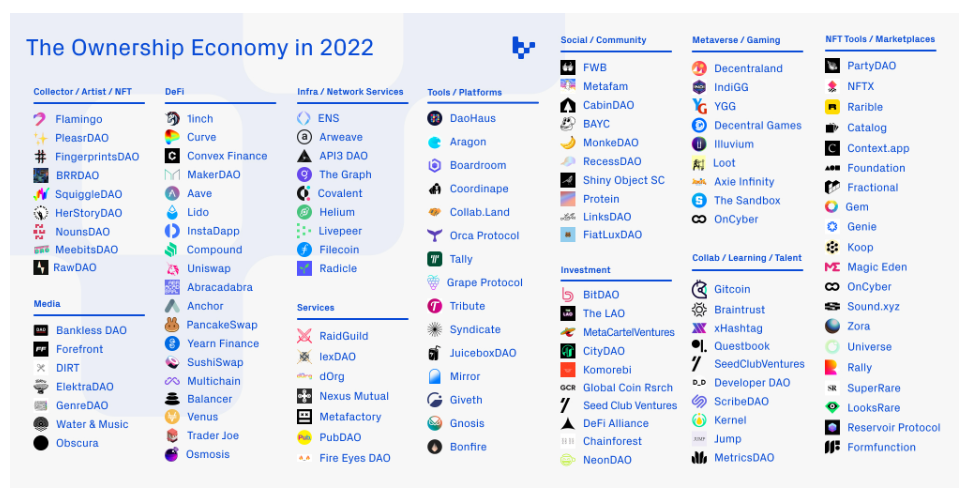
In order to make your life easier in understanding this, I have created this infographic :))
![Source: Own Illustration [Gajaraj, Rohit]](https://images.mirror-media.xyz/publication-images/uPVzzd6SNo8vQfdPnL0ha.png)
What’s next? 💫
Being a creator today requires evolving from being an artist to being a founder. The job has come to encompass product management, design, community engagement, e-commerce, and data science along with being an entertainer. You have to build a team of experts and vendors to help you manage the tools to build a diversified business across platforms.
But with that diversification comes resilience. Creators become less vulnerable to shifts in priorities of the tech giants or their algorithms by owning a direct relationship with their fans. Each creator can assemble a different balance of revenue streams to match their style, no matter how niche. That’s a big win for everyone because creators catering to each of our esoteric interests can build sustainable careers. Instead of just homogeneous, lowest common denominator prime time sit-coms, we get content tuned to every sub-culture in the rainbow. Now there are finally enough creators to support a whole ecosystem of startups helping them turn their passion into their profession.
The potential of Web3 is limitless. With the advent of blockchain, a new era has emerged on the Internet. As such, with all of the human and financial capital inflows into the space, incredible use cases have started to gain mainstream adoption. Ownership is now extending to all kinds of products and networks.
The **Ownership economy is massive and growing quickly. **Many terms in addition to “the ownership economy” are used to describe how technology is empowering new ways for people to become entrepreneurs or solopreneurs. These include the passion economy, the creator economy, the empowerment economy, the freelance economy, and of course the gig economy. But no matter what you call it, it’s clear technology is creating more opportunities for people to become self-employed creators and owners.
‘’The new creator economy encompasses everything creators have always craved -ownership and community-led platforms where all community members are compensated for their time and contributions. Being a creator is enormously hard however we believe everyone will be a creator eventually in some capacity.’’

Future projections 🔮
- Expect next-gen financial support for creators will arise. Areas around cryptocurrency, DeFi (decentralized finance), and the NFT market will continue to grow, and so will services looking to help creators.
- Expect many more creators to embrace NFTs in their own communities as they discover how much better they can monetize by selling digital goods directly to their fans vs banner ads and other web2 monetization methods.
- New startups are carving out specific services from both traditional and new tech incumbents ‒ transforming how content is created, produced, financed, distributed, monetized, engaged with, and owned within digital communities.
- New web3 users who earn tokens through games and NFTs will likely choose to save those tokens in DeFi protocols vs tradfi banks given the better rates and user experience, as new token distribution designs are boosting user loyalty.
- Expect new platforms, new partnerships, and new ways of doing things to raise customer awareness and build new and stronger customer relationships and experiences that are truly exciting.
- The Creator Economy is also shaping the Future of Business. If you’re not creating content, you’re consuming it. In a way, you are contributing to this business trend. The only thing that is left to be seen is if or how long it will take for the creator economy to overtake the traditional economy.
- The Ownership economy is massive and growing quickly. Expect user ownership can jumpstart; though, sustaining it is tougher. User ownership leads to richer ecosystems of projects and contributors.
You can support me and be a part of my amazing journey of WEB3 by purchasing this NFT. I`ll be writing on WEB3, Creator & Ownership Economy, NFTs, and Metaverse.
This article is authored by Rohit Gajaraj as part of the Master Thesis “The Creator & Ownership Economy: The primer on the state of Web3” under the supervision of Prof. Dr. Isabell M. Welpe (Isabell Welpe), Chair for Strategy and Organization at the Technical University of Munich. If you have any questions or you are interested in the full research report and Executive Summary, please don’t hesitate to get in touch with me over email, Linkedin, or Twitter.
Happy to connect!! 😊
#WAGMI 🚀